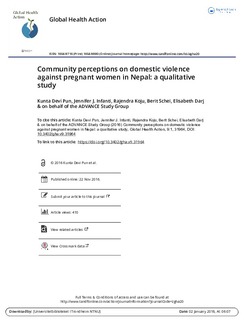| dc.contributor.author | Pun, Kunta Devi | |
| dc.contributor.author | Infanti, Jennifer | |
| dc.contributor.author | Koju, Rajendra | |
| dc.contributor.author | Schei, Berit | |
| dc.contributor.author | Darj, Elisabeth | |
| dc.date.accessioned | 2018-01-03T08:45:01Z | |
| dc.date.available | 2018-01-03T08:45:01Z | |
| dc.date.created | 2016-11-24T09:43:12Z | |
| dc.date.issued | 2016 | |
| dc.identifier.issn | 1654-9880 | |
| dc.identifier.uri | http://hdl.handle.net/11250/2474211 | |
| dc.description.abstract | Background: Globally, knowledge of health sector options to respond to domestic violence during pregnancy is increasing, but this topic is under-investigated in Nepal. This gap affects the provision of adequate antenatal care services and understanding of factors that influence women’s willingness and ability to use available services. It is critical to know more about the social norms in a community that promote and prevent women experiencing domestic violence from seeking antenatal care. Objective: To explore community perceptions of domestic violence against pregnant women. Methods: A qualitative study was conducted in Dhulikhel municipality, involving 41 men and 76 women in 12 focus group discussions in different gender and family role separated groups. The interviews were recorded, transcribed in verbatim, and analyzed using content analysis. A socio-ecological model was used as a theoretical framework to illustrate linkages between individual, relationship, community, and societal influences on perceptions of domestic violence during pregnancy. Results: The community recognized different forms of violence during pregnancy threatening women’s physical and psychological health and presenting obstacles to seeking antenatal care. Some types of culturally specific violence were considered particularly harmful, such as pressure to give birth to sons, denial of food, and forcing pregnant women to do hard physical work during pregnancy, which may leave daughters-in-law vulnerable to domestic violence in extended families. A culture where violence is normalized and endurance and family reconciliation are promoted above individual health was perceived to cause women to tolerate and accept the situation. Participants suggested actions and strategies to address continuing violence, which indicated a societal transition toward increased awareness and changing attitudes and practices. Conclusions: Domestic violence during pregnancy needs to be addressed at different levels in Nepal, where women are often dependent on others for access to health care. Social norms were perceived to be shifting toward reduced acceptance of violence against women, but restrictions on women’s life options, movement, and decision-making authority were still considered impediments to pregnant women’s health. | nb_NO |
| dc.language.iso | eng | nb_NO |
| dc.publisher | Taylor & Francis Open | nb_NO |
| dc.relation.uri | http://www.tandfonline.com/doi/pdf/10.3402/gha.v9.31964?needAccess=true | |
| dc.rights | Navngivelse 4.0 Internasjonal | * |
| dc.rights.uri | http://creativecommons.org/licenses/by/4.0/deed.no | * |
| dc.subject | Samfunnsvitenskap | nb_NO |
| dc.subject | Social sciences | nb_NO |
| dc.title | Community perceptions on domestic violence against pregnant women in Nepal: a qualitative study | nb_NO |
| dc.type | Journal article | nb_NO |
| dc.type | Peer reviewed | nb_NO |
| dc.description.version | publishedVersion | nb_NO |
| dc.subject.nsi | VDP::Medisinske fag: 700 | nb_NO |
| dc.subject.nsi | VDP::Midical sciences: 700 | nb_NO |
| dc.source.volume | 9 | nb_NO |
| dc.source.journal | Global health action | nb_NO |
| dc.source.issue | 1 | nb_NO |
| dc.identifier.doi | 10.3402/gha.v9.31964 | |
| dc.identifier.cristin | 1403663 | |
| dc.relation.project | Norges forskningsråd: 220893 | nb_NO |
| dc.description.localcode | © 2016 Kunta Devi Pun et al. This is an Open Access article distributed under the terms of the Creative Commons Attribution 4.0 International License (http://creativecommons.org/licenses/by/4.0/) | nb_NO |
| cristin.unitcode | 194,65,20,0 | |
| cristin.unitname | Institutt for samfunnsmedisin og sykepleie | |
| cristin.ispublished | true | |
| cristin.fulltext | original | |
| cristin.qualitycode | 1 | |

